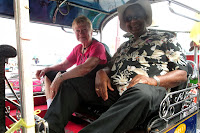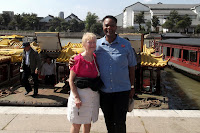After
breakfast, we completed the last of our packing and exited our cabin at 8:05
AM. We were only five minutes past the
required checkout time, so we didn’t get yelled at by the cabin steward this
time! (That’s probably a record for
us!) After that, we waited in the Princess
Theater until about 9:30 AM, when they announced that it was finally our turn
to disembark.
A
long line was waiting to go through Singapore immigration, and for some time,
the line wasn’t even moving. After we finally
made it through Singapore immigration and found our luggage, none of the Princess
personnel seemed available to provide directions to our tour bus; therefore,
Jesse walked around the parking lot until he finally found it, and we were
almost the last to board. We had signed
up for a Princess Singapore 6-hour tour, with a drop-off at the airport. It was easy to remember our tour guide’s name
(Jeremy) and the driver’s name (Andrew) because we have two grandsons with
those names also.
Jeremy
gave us a 5-minute history lesson on Singapore, which is a city, state, and
country; it is the southernmost point of mainland Southeast Asia; and it is the
financial center for the region. During
their WWII occupation, Japan killed thousands of people indiscriminately, and
the city was practically leveled. Except
for Chinatown and Little India, today’s Singapore is a very modern city with
numerous skyscrapers, expensive commercial districts, and stores. Jeremy told us a lot about the strict laws
and penalties in Singapore. It is
probably the only place in the world that has banned chewing gum. Possession of 5 grams of heroin gets one the
death penalty. And terrorists are
imprisoned without trial. Needless to
say, there is very little crime in Singapore, but it definitely lacks a lot of
freedoms, including freedom of speech.
Their president earns 4 times as much as the US President, but he was
elected by a 35 percent vote.
Singapore
reportedly has the largest per capita percentage of millionaires in the world;
however, according to Jeremy, 80 percent of the population lives in Government
apartments, and only one out of every 12 people own cars. Private 100 square meter apartments sell for
$4 or 5 million US each. You can expect
to pay $75,000 US for a Toyota Camry and another $40,000 for tax and
licenses. Mercedes is the most popular
car in Singapore, for a total price of about $220,000 US. English is taught as their first language
(though most people grow up speaking some other language), and signs of streets
and stores are in English except in Chinatown.
 |
| National Orchid Garden |
Our
tour started at Mt. Faber, the highest point in town. From there, we stopped for a photo stop with magnificent
views of the harbor, Sentosa Island, and the downtown district. Our next stop was the National Orchid Garden,
perched on a hill atop the Singapore Botanic Gardens. Although most people probably recognize an orchid
corsage (even flower-ignorant people like us), it was amazing to see that
orchids can have so many colors and shapes.
This world’s largest collection of orchids houses over 1,000 species and
2,000 hybrids of orchids, most growing in a natural environment with tropical
trees. Although Sally considered staying
on the bus (because of her lack of energy and the hot climate), after thinking
about how a couple of our plant-loving daughters-in-law would love the
opportunity, she decided to participate.
(It was about a half-hour walk, partly in the shade.)
Our
lunch was at a Chinese restaurant, “Peony Jade,” where the food was served family
style, with serving dishes placed in the center of the table on a “lazy Susan” as
in other Chinese restaurants we had visited. Afterward, we visited the nearby Buddha
Tooth Relic Temple. Of all of the
Buddhist temples we visited, this was the most beautiful, well-maintained, and
comfortable (since it was air-conditioned).
We took an elevator to the fourth floor to the Sacred Light Hall which
contains the Buddha tooth relic. The
relic is housed within a stupa (a mound-like structure) made from 420 kilograms
of gold; the stupa is surrounded by gold tiles and covered by a gold
canopy. Only monks are allowed into the
relic chamber, where they conduct daily services. That large, locked room is closed off by bullet-proof
glass, but visitors can view the relic chamber from the public viewing area. Of course we had removed our shoes in order
to view the interior rooms of the temple; except for the gold room, photos were
permitted.
At
the end of the tour, we arrived at the Singapore airport about 4:00 PM, where
we planned to patiently wait until our “red-eye” flight scheduled for 1:30 AM. After collecting our luggage and finding
restrooms, Sally changed from her hot-weather clothes to warmer clothes for our
flight home. Since there were relatively
few chairs in the main lobby, we were careful to maintain our seats near the
main entrance, where we sat watching people arrive. We also noticed groups of soldiers, in sets
of three, walking past about every 20 minutes in formation, patrolling the
airport with automatic weapons. At about
7:45 PM, we found a Quiznos in the basement (called Level 1, which initially confused
us), where we ate our dinner. When we
returned to the main lobby, we discovered that our Japan Air flight to Tokyo
had changed from 1:45 to 2:30 AM. Sally
began to experience some anxiety about basic survival through this long trip
home.
Our
tour guide had warned passengers of airport procedures, namely that passengers
could line up for ticketing 3 hours before a flight and then proceed to the
gate; one hour before the flight, people would be allowed into the gate
area. After seeing a large group of
uniformed Japanese school kids enter the airport and line up for ticketing,
Jesse (and soon Sally) lined up behind them, even though it was slightly before
3 hours. However, we two were soon
directed to a separate line where a few business class passengers had received
tickets, and we proceeded (before the students) to Level 3 to sit near the gate. Actually, when the students came to Level 3,
they sat in a nearby Starbucks for a long time, which surprised us. When the gated area was unlocked, we lined up
for security and then sat for a half-hour more at the gate before boarding the
plane.
Once
on the Japan Air flight, we were shocked to receive seats on the front of the
coach section, with about 3 feet in front of us, enough that Jesse could
stretch out his legs. (Jesse stood up to
look at row numbers because he couldn’t believe we were given these preferred seats!) In that row were 6 seats across the middle,
with 2 seats on each side of the plane; and our 2 seats were on one side. Although we wanted to sleep (if possible),
Jesse tried to stay awake enough for the frequent serving of food. Even Sally eventually slept for a while.
Our
wait at the Tokyo airport was short. On
the next flight from Tokyo to Dallas/Fort Worth, our seats were in the
next-to-last row on the plane in the center section. The bright side was that we were nearly
across the aisle from a restroom; and since the center section had 4 seats
across (and we sat one side of the center), we could leave our seats without
bothering a stranger. We both slept
some and we also watched movies to help pass the 11.5 hours – an eternity, it
seemed! Movies included “Man of Steel,” “The Lone Ranger,” “White House Down,” and “The
Way, Way Back.” At 9:00 AM on Sat., 25
Oct the plane landed in DFW (but it was 10:00 PM on Fri., 26 Oct in Singapore);
thus, we landed before we had taken off!
At
the DFW airport, being the last ones to leave the plane, we were also last in
line to claim our luggage, go through customs, recheck our luggage, and go
through security. However, soon an
airport worker asked if we needed a wheelchair, and then he opened up priority
lane for us as a shortcut to the security conveyor belt. Elated about that good luck, I wondered if I
looked 90 years old (like I felt) or what??? Jesse came up with the probable explanation: the
worker didn’t think we were a married couple; instead, he suspected that Jesse,
who was lugging all of our carry-on luggage, was helping an elderly lady
through the boarding procedure. (Well,
that part was correct!) Then, we had a
long wait for our flight to Peoria (scheduled for 3:35 PM).
The
flight from DFW to Peoria took only 1 hr. 37 min., landing at 5:20 PM. Due to construction that closed one lane of traffic
on I-80 before the bridge crossing the Mississippi River, the last part of our
2-hour drive home took about 20 minutes more than usual. After that, Jesse was so exhausted that Sally
coached him on every turn of the road (and other drivers passed him at every
opportunity). But we made it home safely
before 8:00 PM Fri. (which was 9:00 AM Sat. in Singapore). [We were gone so long that Jesse had
forgotten how to use the TV remote, and Sally had forgotten how to use the
microwave!]
It’s
Saturday morning, 26 Oct 2013, here in Bettendorf now, with our EXTREMELY fast
internet (when compared to the ship’s).
We weighed in and after 32 days of overeating and found that we had only
gained about five pounds each, which should be easy to lose, once we resume our
water aerobics next week.
Signing off at the
end of another lovely (but exhausting) cruise!

















